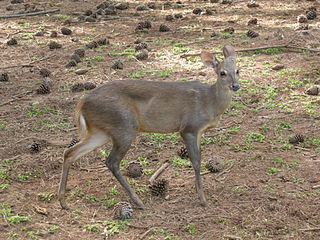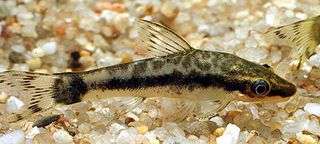
Mato Grosso is one of the states of Brazil, the third largest by area, located in the Central-West region. The state has 1.66% of the Brazilian population and is responsible for 1.9% of the Brazilian GDP.

The Paraguay River is a major river in south-central South America, running through Brazil, Bolivia, Paraguay and Argentina. It flows about 2,695 kilometres (1,675 mi) from its headwaters in the Brazilian state of Mato Grosso to its confluence with the Paraná River north of Corrientes and Resistencia.

Corydoras is a genus of freshwater catfish in the family Callichthyidae and subfamily Corydoradinae. The species usually have more restricted areas of endemism than other callichthyids, but the area of distribution of the entire genus almost equals the area of distribution of the family, except for Panama where Corydoras is not present. Corydoras species are distributed in South America where they can be found from the east of the Andes to the Atlantic coast, from Trinidad to the Río de la Plata drainage in northern Argentina. Species assigned to Corydoras display a broad diversity of body shapes and coloration. Corydoras are small fish, ranging from 2.5 to 12 cm in SL., and are protected from predators by their body armor and by their sharp, typically venomous spines.

Otocinclus is a genus of catfish in the family Loricariidae native to South America, commonly known as "dwarf suckers" or "otos". This genus, like other loricariids, is characterized by rows of armour plating covering the body, as well as the underslung suckermouth. They are generally small in size; O. tapirape is the smallest of the species (2.4 cm), while O. flexilis is the biggest (5.5 cm). These species have adaptations that allow them to breathe air. A duct forms at the junction between the esophagus and the stomach and expands into an enlarged, ring-like diverticulum, characteristic of this genus, which allows air-breathing. Otocinclus are popular aquarium fish, and they are often purchased as algae eaters. It is difficult to breed them in captivity, and only wild caught Otocinclus are available to hobbyists. This genus is widely distributed east of the Andes of South America, throughout the lowlands from northern Venezuela to northern Argentina, but are generally absent from the Amazon and the Orinoco lowlands.

The zebra oto or tiger oto is a fish of the genus Otocinclus of the family Loricariidae that originates from Peru.

Brockets or brocket deer are the species of deer in the genus Mazama. They are medium to small in size, and are found in the Yucatán Peninsula, Central and South America, and the island of Trinidad. Most species are primarily found in forests. They are superficially similar to the African duikers and the Asian muntjacs, but unrelated. About 10 species of brocket deer are described.

Guaporé River is a river in western Brazil and northeastern Bolivia. It is 1,260 km (780 mi) long; 920 km (570 mi) of the river forms the border between Brazil and Bolivia.

The golden otocinclus is one of the smallest known suckermouth catfish, often called a 'dwarf oto'. Endemic to Southeast Brazil, this herbivorous, rheophilic, bottom-feeder only grows to around 4 cm (1.6 in) in length. The close relatives of this small fish are often used for the purpose of controlling algae in small home aquariums, under the name Otocinclus affinis. In reality, they belong to the species O. vittatus, O. vestitus and O. macrospilus. The real M. affinis is not present in the aquarium hobby.

The double-collared seedeater is a species of bird in the family Thraupidae.
The Cabaçal River is a river of Mato Grosso state in western Brazil. It is a tributary of the Paraguay River.
Otocinclus xakriaba is a species of suckermouth catfish native to the São Francisco river basin in South America. This species reaches a maximum length of 3.1 centimetres (1.2 in) (SL).
Otocinclus juruenae is a species of armoured catfish endemic to the Juruena river in Mato Grosso, Brazil.
Otocinclus huaorani is a species of armoured catfish in the family Loricariidae found in Colombia, Ecuador and Peru.
Otocinclus mimulus is a species of armoured catfish found in small tributaries of the Monday river, itself a tributary of the Paraná river.
The Chaco linguistic area is a linguistic area that includes various South American language families and isolates of the Chaco region of South America, in southern Brazil, southeastern Bolivia, Paraguay, Uruguay, and Argentina.
Otocinclus caxarari is a species of catfish in the family Loricariidae. It is native to South America, where it occurs in the Madeira River basin. It is known to reach 2.6 cm SL.
Otocinclus flexilis, known in the aquarium trade as the peppered otocinclus, is a species of catfish in the family Loricariidae. It is native to South America, where it is known from the Lagoa Dos Patos drainage basin in Brazil. The species reaches 6.8 cm in total length.
Otocinclus hasemani is a species of catfish in the family Loricariidae. It is native to South America, where it occurs in the Tocantins and Parnaíba basins. It reaches 2.7 cm SL.
Otocinclus hoppei is a species of catfish in the family Loricariidae. It is native to South America, where it occurs in the Amazon River basin. The species reaches 3.3 cm SL.

Otocinclus macrospilus is a species of catfish in the family Loricariidae. It is native to South America, where it is known from the Amazon River basin. The species reaches 3.5 cm SL and is found in the aquarium trade, where it is sometimes referred to as the common otocinclus or dwarf otocinclus, both of which can lead to confusion with other Otocinclus and Macrotocinclus species.









